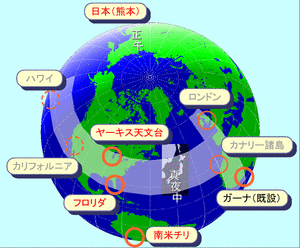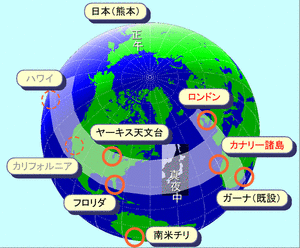Development of constellation camera "i-CAN"
-- "i-CAN" installation sites --
We selected installation sites for constellation camera "i-CAN" according to the following criteria:
- In the area being in the nighttime during the daytime in Japan
- In the area with assured infrastructure and accessibility for maintenance
- To cover a wide range of latitudes and longitudes
- To operate in cooperation with existing Ghana Internet Observatory
"i-CAN" installation sites scheduled for the first year (FY 2005) are Japan (Kumamoto), Yerkes Observatory, Florida, and Chile (sites shown in red below).
 Yerkes, Florida, and Chile are located at approximately the same longitude (within one-hour time difference). Features of the three sites are given below:
Yerkes, Florida, and Chile are located at approximately the same longitude (within one-hour time difference). Features of the three sites are given below:
- Yerkes Observatory: Yerkes Observatory has the world largest refractor telescope. Located at latitude comparable to Sapporo (Japan) and Rome (Italy).
- Florida: University of Florida is a leading institute of observation/research of Jovian radio emission. Located at latitude comparable to Okinawa (Japan) and Cairo (Egypt).
- Chile: In Chile, a radio-wave observation facility called "ALMA" is under construction. Currently, this is the single site located in the southern hemisphere.
The two sites in the US are useful for learning "the difference of stars when they are seen from the different latitudes". The Chilean site provides star images in the southern sky unfamiliar to people in the northern hemisphere. Since there is a time difference of 5 to 6 hours between Ghana and these three sites, it happens that the constellation seen overhead in Ghana can be seen near the horizon in other sites, and vice versa. This kind of experience will teach us we are living on earth surrounded by stars.
We are planning to add two sites (shown in red in the figure below) in the second year (FY 2006).
 London and Canary Islands have been selected to cover different latitudes at approximately the same longitude as Ghana. However, London is still under consideration because we are yet to confirm the necessity of such a high-latitude site. There is a possibility to expand in the longitude direction (California or Hawaii). This year, we will carefully study the sites considering astronomical education curriculum, and select the site so as to achieve maximum results.
London and Canary Islands have been selected to cover different latitudes at approximately the same longitude as Ghana. However, London is still under consideration because we are yet to confirm the necessity of such a high-latitude site. There is a possibility to expand in the longitude direction (California or Hawaii). This year, we will carefully study the sites considering astronomical education curriculum, and select the site so as to achieve maximum results.


